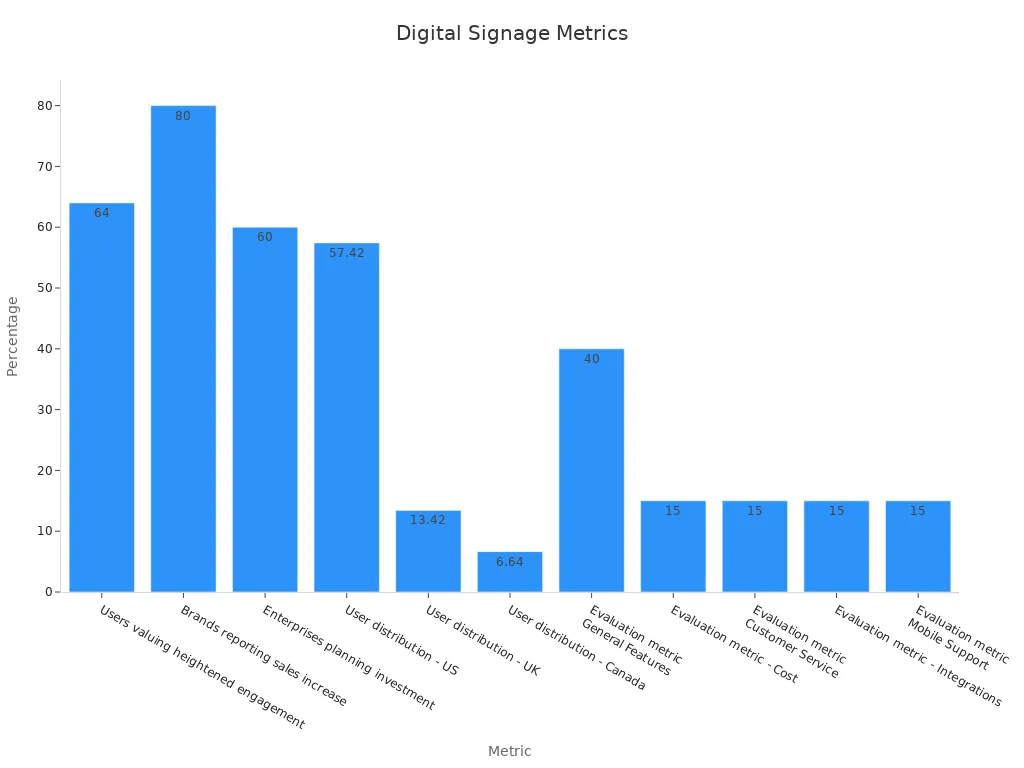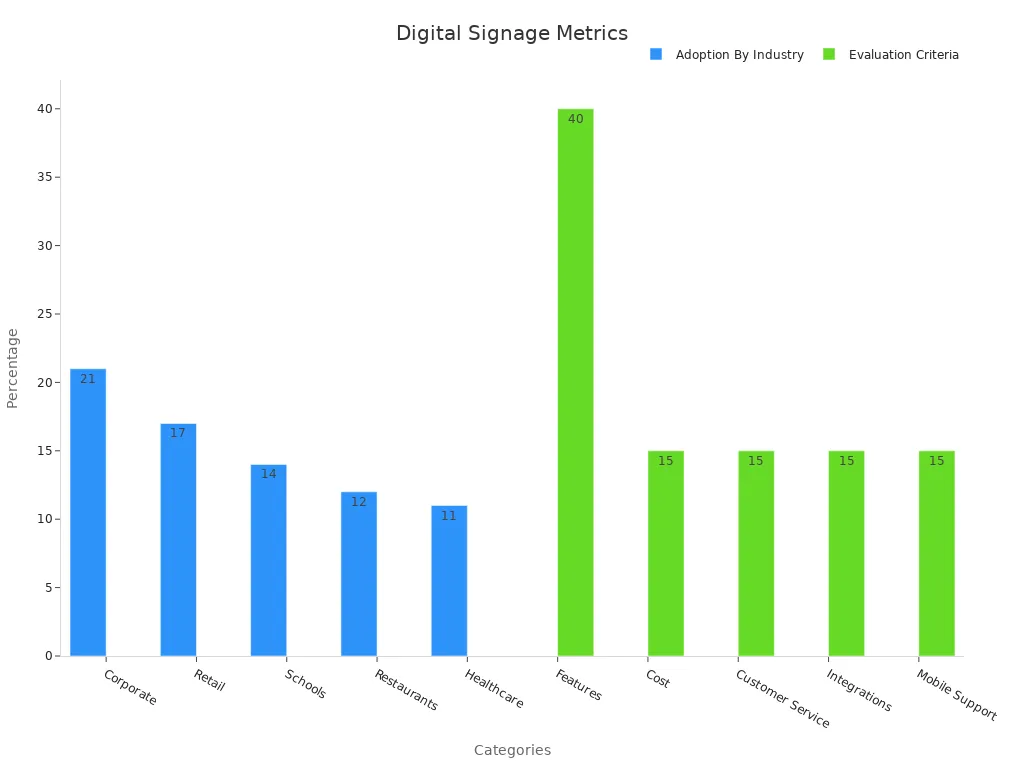Best Free Digital Signage Software Solutions in 2025

Are you searching for the best digital signage software in 2025? There are good options like PosterBooking for easy cloud use. Yodeck is great if you need many screens. Screenly OSE is best if you want open-source choices. Free digital signage software helps businesses, schools, and restaurants get noticed. It does not cost a lot of money.
Digital displays get 400% more views than regular signs.
80% of brands using digital signage software see sales go up by 33%.
60% of businesses want to spend money on digital signage soon.

You can find the best digital signage software for your needs. It works for one TV or a big network.
Key Takeaways
Free digital signage software is a cheap way to make cool displays. These displays help you sell more and get people interested. Cloud-based solutions let you control screens from any place. You can add more screens without much trouble. Open-source options give you full control and good security. But you need some tech skills to set them up. Pick software that works with your devices and is easy to use. This helps you change content fast and keep it new. Try free plans first to see what features you like. Upgrade later if you need more screens or better tools.
Digital Signage Software Overview
What Is Digital Signage Software
You can spot digital screens in many places. They are in stores, airports, and hospitals. These screens show menus, ads, news, or directions. Digital signage software helps you pick what goes on these screens. You can upload videos, pictures, or messages. You can also set times for them to play. Some platforms let you control one screen. Others help you manage many screens at once.
Digital signage software links to players, apps, and displays. This setup lets you share content that is live or interactive. It can also show things just for certain people. Stores use digital signage to help sell more products. It also makes shopping more fun. In hospitals, digital signs help people find their way. They also help patients feel less bored while waiting. Airports use digital signage for flight updates and alerts. Restaurants use digital menu boards to show food and deals.
The digital signage software market is getting bigger. North America is ahead because many stores want these tools. Asia-Pacific is growing fast as more people see the benefits. Experts think the market could reach $27 billion by 2032. New tech like AI and cloud will make it even better.
Why Choose Free Digital Signage Solutions
Many people want free digital signage software because of the price. Paid platforms can cost $20 to $40 per screen each month. That gets expensive if you have lots of screens. Free digital signage helps you start without spending much money. Many free options work with design tools you already know. This makes it easy to create good content.
Small businesses, schools, and restaurants like free digital signage. It is simple to use and saves money. You can test features and see what you like. You only pay if you want more advanced tools later. Free digital signage lets you grow your display network when you are ready.
Best Free Digital Signage Software

Cloud-Based Free Digital Signage Solutions
Cloud-based free digital signage makes screen management simple. You can change your content from any place. There is no need to install big programs or worry about updates. Most cloud-based digital signage cms platforms let you add pictures, videos, and live feeds. You can set times for your content and check reports on your screens.
Did you know? In 2025, 65% of new digital signage uses cloud-based systems. These platforms let you update content in just minutes. Companies see a 78% drop in IT help requests after switching to cloud-based digital signage software. This means you fix fewer problems and spend more time showing good content.
Here are some top digital signage software options that use the cloud:
Platform | Standout Features | Supported Devices | Unique Advantages |
|---|---|---|---|
PosterBooking | Unlimited screens, drag-and-drop editor, free digital signage templates | Android TV, Fire TV, Windows, Raspberry Pi | Easy setup, great for beginners |
Yodeck | Multi-screen support, remote updates, free digital signage templates | Raspberry Pi, Windows, Mac, Linux, Android | Scales well for big networks |
Novisign | Interactive widgets, real-time updates, free digital signage templates | Android, Chrome OS, Windows | Good for touch screens |
OnSign TV | Real-time monitoring, offline playback | Android, Windows, Chrome OS | Reliable for 24/7 displays |
ScreenCloud | App integrations, cloud-based digital signage software, analytics | Android, Amazon Fire TV, LG webOS, Samsung Tizen | Works with many devices |
AbleSign | Simple interface, free cms platforms, easy scheduling | Android TV, Fire TV | Fast setup, no credit card needed |
OptiSigns | Templates, playlist scheduling, top 10 free cms platforms | Android, Fire TV, Windows, Linux | Great for small businesses |
Most digital signage cms platforms work with Android, Fire TV, and Windows. Some also work with Raspberry Pi, which is good for saving money. Many have free digital signage templates, so you do not need to design everything.
Cloud-based free digital signage solutions help you grow fast. You can add more screens as your business gets bigger. You also get real-time updates and analytics. This helps you know what content is best. Many platforms have free cms platforms with basic tools. If you want more, you can upgrade later.
Free Digital Signage for TV
Do you want to turn your TV into a smart display? Free digital signage for tv makes it easy to do this. You do not need special hardware. Most platforms let you use Android TV, Fire TV Stick, or a smart TV browser. You can show menus, ads, or news right on your screen.
Here are some of the best software for digital signage on TV:
PosterBooking: You can put the app on your Android TV or Fire TV. It lets you use playlists, schedules, and free digital signage templates. You control it from your phone or laptop.
AbleSign: This platform is great for free digital signage for tv. You can set it up in just a few minutes. It works well for restaurants, schools, and waiting rooms.
AIScreen: This digital signage platform lets you show content on TVs in public places. You get real-time weather, clock widgets, and remote control. You can manage many screens from anywhere. AIScreen supports videos, sound, graphics, and animation. Many users like its support and easy setup.
ScreenCloud: You can use this digital signage cms on almost any smart TV. It has app integrations and analytics. You can manage screens in different places at the same time.
Tip: If you want to use tablets or many screens, Yodeck and Novisign are good picks. They support touch screens and let you control many displays at once.
Free digital signage for tv helps you reach more people. You can show moving content that gets attention. Many platforms offer android free digital signage solutions, so you can use cheap devices. You also get access to top 10 free cms platforms, making it easy to try different tools.
When you use a digital signage cms, you get more than slideshows. You can add widgets, live news, or social media feeds. Many free cms platforms have these features. You can start with free digital signage software and upgrade if you need more.
Metric Name | What It Means for You |
|---|---|
Adoption Rate | Shows how many users try new features. High rates mean easy-to-use digital signage cms. |
Time to Value | Measures how fast you see results. Short times mean you get benefits quickly. |
Usage Frequency | Tells you how often people use the platform. High frequency means users love it. |
Churn Rate | Shows how many users stop using the software. Low churn means people stay happy. |
Net Promoter Score (NPS) | Measures if users would recommend the platform. High scores mean strong satisfaction. |
The best digital signage software platforms focus on easy setup, fast results, and happy users. Many offer free digital signage solutions with good support and active groups. You can find free digital signage for tv, tablets, or even big video walls.
If you want to try android free digital signage solutions, look for platforms with free cms platforms and lots of templates. You can test different digital signage cms tools and see what works best for your business.
Open-Source Free Digital Signage
Self-Hosted Options
If you want more control, open-source free digital signage is a good choice. You can run the software on your own computers or servers. This lets you decide how things work. Some well-known self-hosted options are:
Screenly OSE: You can use this open-source cms for digital signage with a Raspberry Pi. It is easy to use and works for menus, ads, or school screens.
piSignage: This digital signage cms is good for small businesses. You can manage screens from your own network.
Anthias: This one looks modern and is simple to set up. It is great for schools and offices.
Concerto: You can show news, events, and alerts with this platform. Many colleges use it.
Garlic Player: You can use this for video walls or just one screen. It supports many file types.
When you use open-source free digital signage, you join a big group of users. People help each other in forums and share tips. You can find guides and stories from real users. Many people say these platforms work well. You get remote management, strong security, and real-time monitoring. You can add more screens as you grow. Built-in analytics show how your screens are doing. If you know tech, you can change many things.
Pros and Cons
You might ask how open-source free digital signage is different from cloud-based tools. Here is a quick look:
Aspect | Cloud-based Digital Signage | On-premise Digital Signage |
|---|---|---|
Upfront Cost | Lower upfront costs; subscription-based with pay-as-you-go pricing | Significant upfront investment for hardware and software license |
Cost-effectiveness | More affordable for small to medium deployments; pay recurring fees | Potentially more cost-effective over 6-8 years for large enterprises with many screens |
Deployment Scale | Suitable for up to 20-50 screens or fewer | Better suited for large-scale deployments with many screens |
Management | Remote management via internet; no need for dedicated IT staff | Requires dedicated IT resources for maintenance, updates, and troubleshooting |
Scalability | Easy to scale up or down instantly without downtime or extra cost | Scaling is costly and time-consuming; requires physical access and additional investment |
Technical Ownership | Technical ownership transferred to provider; minimal internal IT effort | Full control over hardware, software, and security |
Security | Advanced security managed by vendor; data stored offsite | Complete control over security; responsibility lies with the organization |
Connectivity Requirement | Requires reliable internet connection; some solutions offer offline playback for limited time | No internet dependency for content updates; requires physical access for updates |
Customization & Integration | Limited compared to on-premise; depends on provider offerings | Extensive customization and integration capabilities |
Multi-location Support | Ideal for multi-location deployments due to remote access | Less suitable for multi-location due to need for physical presence |
Open-source free digital signage gives you more freedom. You can change the software to fit your needs. You also get strong security and privacy. But you need some tech skills to set up and fix problems. Cloud-based digital signage cms is easier for beginners. It is good if you want to manage screens from anywhere. Free cms platforms in the cloud are great for fast setups. If you want to try the top 10 free cms platforms, start with cloud options. If you want full control, choose open-source.
Comparing Free Digital Signage Solutions
Features and Limitations
When you check out different digital signage cms, you will see each one is different. Some, like TelemetryTV, have cool features. You can update content right away and let many people use it. You can also control screens from far away. These platforms let you use images, videos, and live data feeds. You can add interactive digital signage widgets too. These tools help you make fun displays and get people interested. But there are some limits. You might not get many templates or offline use. Sometimes, cheaper devices do not work as well.
Here is a quick look at some popular choices:
Solution | Strengths | Limitations | Pricing |
|---|---|---|---|
Screenly Open Source Edition | Free, supports images/videos/playlists, HD resolution | Only one screen, Raspberry Pi only, no support/updates | Free |
ScreenCloud | 60+ integrations, built-in design, streams web pages | Higher cost, playback limits at lower tiers | Starts at $60/mo |
NoviSign | Drag-and-drop, proof-of-play, cross-platform | Customization can be tricky, price varies | Starts at $18/mo |
Cloud-based digital signage cms are easy to grow and update fast. You get new software updates without doing anything. You can control your screens from anywhere. On-premise solutions give you more control and keep things safe. But you have to take care of the hardware and updates. Freemium digital signage cms let you try basic stuff for free. You can pay for more features later if you want.
Ideal Use Cases
You may wonder which digital signage cms is best for you. If you have a small shop or restaurant, cloud-based freemium options are good. You can set up digital signage for retail fast. You can show menus or deals with real-time content updates. For schools or offices, on-premise solutions like Screenly Open Source Edition give you privacy and control.
If you want interactive digital signage, pick platforms with touch screens and widgets. These features help you make displays people can use. Digital signage for retail stores uses these tools to get attention and help sales.
Freemium digital signage cms are good for trying things out. You can start with a few screens and add more later. Real-time performance and real-time content updates keep your screens fresh. You can always show the newest news, deals, or alerts.
How to Choose Free Digital Signage Software
Compatibility and Device Support
You want your screens to work without trouble. Always check if the software supports your TVs, monitors, or tablets. Many top platforms let you use smart TVs, regular TVs, and even web browsers. You can often use cheap media players or your own hardware. Some companies offer demo units so you can test before you decide. Try the software on your devices to see if everything runs smoothly. Mobile compatibility matters too. You might want to update your content from your phone or tablet. This gives you more freedom and helps you manage screens from anywhere.
Most user-friendly free digital signage software works with Android, Windows, and smart TVs.
Some platforms even support 4K playback for sharp images.
Free trials help you check if the software fits your setup.
Tip: Make sure the software works with what you already have. This saves money and time.
Ease of Use
You want software that feels simple and quick. Look for a clean dashboard and easy drag-and-drop tools. Many users say that a good user experience makes a big difference. You should be able to upload images, videos, or news in just a few clicks. Scheduling content should not feel confusing. Top-rated platforms score high for their easy design and fast updates. If you can learn it in one afternoon, you know you have a winner.
Feature | Why It Matters |
|---|---|
Drag-and-drop editing | Makes setup fast and simple |
Clear menus | Helps you find tools quickly |
Fast content updates | Keeps your screens fresh |
A smooth user experience means you spend less time fixing problems and more time reaching your audience.
Support and Community
Good support helps you solve problems fast. You want a platform with helpful guides, videos, and a strong user group. Many people join online forums to share tips and ask questions. When you get stuck, quick answers matter. A strong community also means you get new ideas for interactive digital signage. This can boost customer engagement and keep your screens interesting. Experts say that feedback and active groups help everyone learn and grow. You feel part of something bigger, and your displays get better over time.
Getting Started with Free Digital Signage

Quick Setup Guide
You can set up your first digital sign in just a few steps. Start by picking a free digital signage software that works with your device. Many platforms offer free digital signage templates, so you do not need to design everything from scratch. Here is a simple guide to help you get started:
Sign Up: Create a free account on your chosen platform.
Connect Your Device: Download the app or open the web player on your TV, tablet, or computer.
Choose a Template: Pick from free digital signage templates to make your display look great.
Add Content: Upload your images, videos, or messages. You can also use real-time content updates to keep things fresh.
Schedule and Publish: Set times for your content to play. Many platforms let you use real-time updates, so you can change your display anytime.
Tip: Most platforms have step-by-step guides and videos. If you get stuck, check their help center or ask the community.
Tips for Different Devices
You want your digital signage to look good on every screen. Each device has its own tricks for the best results. Here are some tips to help you:
Test your content in different lighting and from different angles. This helps you see if your display is clear and easy to read.
Use free digital signage templates that fit your screen size. Some templates work better on TVs, while others look best on tablets.
Try A/B testing with different layouts. See which one gets more attention from your viewers.
Watch how people react to your signs. You can ask for feedback with a quick survey or just talk to your staff.
Check real-time content updates and see if people notice new messages right away.
A good way to measure how well your device works is to use a simple survey. Ask about things like screen brightness, comfort, and how easy it is to use. Many businesses use a 5-point scale to see what people like or want to change. This helps you make your digital signage better over time.
Remember: Keep your content fresh with real-time content updates. Try new free digital signage templates often to see what works best for your audience.
Overcoming Free Plan Limitations
Common Restrictions
When you use a free digital signage plan, you get a lot of value, but you also face some limits. Most free plans work well for simple needs, but you might run into a few roadblocks as you grow. Here are some common restrictions you should know:
Free plans usually do not promise much uptime. You might not get a service level agreement, so your screens could go down without warning.
You often rely on community support instead of fast, professional help.
Role-based access control is missing or very basic. Everyone may have admin rights, which can cause mistakes.
You get only basic widgets. You cannot use advanced integrations, APIs, or automation tools.
Setting up new screens is manual and device-specific. This takes more time as you add more displays.
Content management is not connected to other systems. You have to upload everything by hand, which can lead to errors.
Free plans do not offer real-time monitoring or alerts. You may not know if something goes wrong until someone tells you.
If you use a free version for one user, these limits feel even bigger. You might find it hard to manage more screens or work with a team. Freemium plans give you a taste of what is possible, but they hold back some of the best features.
Tip: If you plan to grow your network or need more control, keep these limits in mind before you commit to a free plan.
Upgrade Options
When you start to outgrow your free plan, you have some great upgrade options. Moving to a paid or premium plan can unlock many helpful features. Here is what you get when you upgrade from a freemium plan:
You save money on printing because you no longer need to update menus or signs by hand.
Centralized, cloud-based management lets you update all your screens at once, no matter where they are.
You can give different people different roles, so only the right users can make changes.
You get more ways to show content, like videos, live data, and social media feeds.
Adding new screens is easy. You do not need a big IT team to help.
You can schedule content and promotions automatically. This saves time and reduces mistakes.
Your brand looks the same everywhere because you control all your screens from one place.
Security gets better with regular updates and strong access controls.
Upgrading helps you work faster and smarter. You can change prices, menus, or promotions in seconds. Your team spends less time fixing problems and more time helping customers. Freemium plans are great for starting out, but paid plans help you grow and stay ahead.
You have lots of options for digital signage software. OptiSigns is good if you want to set up a TV fast. It works with dongles and has many templates. If you like open-source, Screenly OSE and Xibo let you change how your screens look. ScreenCloud is easy for beginners. It has a simple design and helpful support. Most people notice more people looking at their screens. Many also see more sales. Look at the table below to see the main benefits.
Metric / Benefit | Value / Description |
|---|---|
User Engagement | 64% of users see more attention from viewers |
Sales Lift | 80% of brands report up to 33% more sales |
Sustainability Benefits | Less paper, longer device life, fewer trips for updates |

Try a free plan to find what works for you. You can upgrade later if you need more screens or features.
FAQ
What devices can I use with free digital signage software?
You can use smart TVs, tablets, computers, or even a Raspberry Pi. Many platforms work with Android, Fire TV, and Windows. Always check the software’s website for a full list of supported devices.
Is free digital signage software really free?
Most free plans let you use basic features without paying. You may see limits on screens, templates, or support. If you need more, you can upgrade later.
Can I update my screens from anywhere?
Yes! Cloud-based digital signage lets you change your content from any place with internet. You just log in, pick your screen, and update your message.
Do I need to know how to code?
No coding needed. Most platforms use drag-and-drop editors. You can upload pictures, videos, or use templates. If you want to customize more, some open-source options let you try coding, but it’s not required.
See Also
Top Digital Signage Models And Their Benefits In 2025
Enterprise Digital Signage Systems Compared For Best Solutions
How To Implement Digital Signage For Highest Return On Investment
Exploring Technology And Benefits Of Digital Signage Deployment

